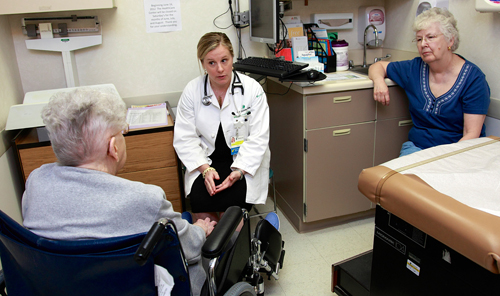New medtech is improving the lives of Christiana Care Health System cancer patients.
Supportive Care of Oncology Patients, or SCOOP, is a patient navigation system using the Aerial Population Health platform. It features an electronic checklist that sets mandatory tasks and milestones during treatment and follow-up, applying a method of care usually associated with advanced cancer to patients with potentially curable cancer.
By following these automated checklists closely, emotionally and financially costly patient emergencies are reduced, according to the data collected from 2016 to 2018 at Christiana Care’s Helen F. Graham Cancer Center & Research Institute.
“The SCOOP protocol is a unique, early intervention tool shown to improve how we treat curative cancer patients effectively, safely and at lower cost,” said Nicholas J. Petrelli, the Bank of America endowed medical director of the Helen F. Graham Cancer Center & Research Institute. “Our experience would indicate that any group of patients at high risk for emergency department visits and hospital admissions could potentially benefit from this kind of approach.”
Christiana Care reported in a press release that, when compared to a control group of similar patients not on the pathway, SCOOP patients experienced:
- Fewer visits to the emergency department (34% vs. 54%)
- Fewer hospital admissions (23% vs. 34%)
- Fewer readmissions (18% vs. 32%)
- An estimated average savings of $1,500 per patient (total cost savings for 207 SCOOP patients through Oct. 31, 2018 was more than $319,000)
How does SCOOP lower these numbers? By adding items to the patient checklist that can be overlooked, such as reminders to assess additional or unmet needs throughout the course of treatment and behavioral health.
“Having that automated process streamlines our workload and helps ensure we don’t miss critical time points for the patient,” said supervising Nurse Navigator Karen Sites, who worked with cancer care management to develop the checklist. “The pathway has helped us to follow a formalized, standard process of care for our patients that starts when they first meet with their cancer care team.”
“The result,” she said, “is better care management throughout their course of treatment with fewer adverse side effects that might otherwise send them back to the hospital.”
Interested in applying for a cancer research trial at Helen F. Graham? Click here.
Before you go...
Please consider supporting Technical.ly to keep our independent journalism strong. Unlike most business-focused media outlets, we don’t have a paywall. Instead, we count on your personal and organizational support.
3 ways to support our work:- Contribute to the Journalism Fund. Charitable giving ensures our information remains free and accessible for residents to discover workforce programs and entrepreneurship pathways. This includes philanthropic grants and individual tax-deductible donations from readers like you.
- Use our Preferred Partners. Our directory of vetted providers offers high-quality recommendations for services our readers need, and each referral supports our journalism.
- Use our services. If you need entrepreneurs and tech leaders to buy your services, are seeking technologists to hire or want more professionals to know about your ecosystem, Technical.ly has the biggest and most engaged audience in the mid-Atlantic. We help companies tell their stories and answer big questions to meet and serve our community.
Join our growing Slack community
Join 5,000 tech professionals and entrepreneurs in our community Slack today!

The person charged in the UnitedHealthcare CEO shooting had a ton of tech connections

From rejection to innovation: How I built a tool to beat AI hiring algorithms at their own game

Where are the country’s most vibrant tech and startup communities?



